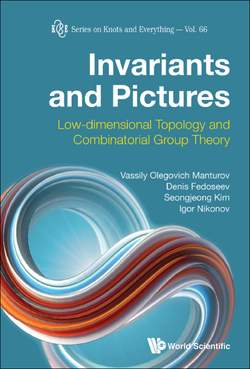Читать книгу Invariants And Pictures: Low-dimensional Topology And Combinatorial Group Theory - Vassily Olegovich Manturov - Страница 30
На сайте Литреса книга снята с продажи.
3.2Curve reduction on surfaces
ОглавлениеLet us fix a two-dimensional manifold Σ. For simplicity we assume Σ to be oriented and closed, i.e. to be the sphere with g handles, g ≥ 0.
We are interested in homotopy classes of curves in Σ, that are also called free loops.
From the topological point of view these curves correspond to conjugacy classes of the group π1 (Sg). We denote the set of homotopy classes of curves in Σ as (Σ).
We shall consider immersions S1 → Σ in general position, i.e. immersions such that all the points having more than one preimage are transverse double points, i.e. points of transverse intersections of the images of two arcs in S1.
Note that any curve can be approximated by a curve in general position. Since curves, which are close to each other, represent the same homotopy class, we can consider immersions in general positions as representatives of the free loops.
A diagram D in a closed surface Σ is a 4-graph Γ embedded in Σ, so that the complement Σ\Γ is a union of two dimensional cells. The graph Γ is called the diagram graph of D.
Analogously, one can define a diagram in a non compact surface or surface with boundary.
We shall not distinguish immersions which are combinatorially equivalent. We shall call such immersions diagrams.
The general position argument implies
Proposition 3.1. Two immersions are homotopy equivalent if and only if one immersion can be obtained from the other by a sequence of Reidemeister moves, see Fig. 3.19.
Fig. 3.19Reidemeister moves for circle immersions in a two dimensional surface
Proposition 3.1 can be thought of as definition of the set (Σ).
In the present section we consider a combinatorial algorithm of free loop recognition, following mainly the article [Hass and Scott, 1994] of J. Hass and P. Scott. Their paper gives a simple answer to the question due to V. G. Turaev [Turaev, 1989]:
Let s0 and s1 be homotopical curves in a surface and each of them have k double points. Does there exist a homotopy st between s0 and s1 such that any curve st has no more than k double points?
The theorems given below are proved in [Hass and Scott, 1994]:
Theorem 3.3. Let s0 and s1 be homotopic curves in general position in a surface and each of them minimise the number of self-crossings in its homotopy class. Then there exists a homotopy st from s0 to s1 such that st is self transversal for every t and the number of double points (counted with multiplicities) of st does not depend on t.
Theorem 3.4. Let s0 be a curve in general position in the surface Σ. Then there is a homotopy st from so to a curve s1 which has the minimal number of double points in the homotopy class, and the number of double points in st does not increase with t.
A solution to Turaev’s problem follows immediately from these theorems: given two curves s0 and s1, one can homotop them to minimal curves thanks to Theorem 3.4, and take a homotopy between and from Theorem 3.3.
Remark 3.2. Theorem 3.3 is not valid for unions of curves. For example, one cannot permute the components in Fig. 3.20 without adding new intersection points. On the other side, Theorem 3.4 remains true.
Fig. 3.20Non-equivalent minimal pairs of curves
